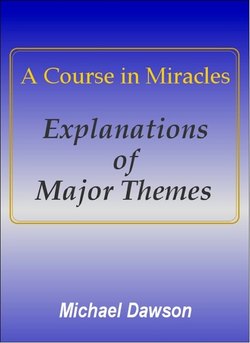Читать книгу A Course in Miracles - Explanations of Major Themes - Michael Dawson - Страница 5
На сайте Литреса книга снята с продажи.
How 'A Course in Miracles' Came
ОглавлениеReprinted from Healing the Cause
The way the Course came to be written illustrates very well the principles to be found within its pages. In 1957 William Thetford, a professor of medical psychology, was made Director of the Psychology Department at the Columbia-Presbyterian Medical Center in New York City. The following year he appointed Helen Schucman, an associate professor of medical psychology, to head a research project. Although they worked well together professionally, their personal and departmental relationships were marked with much criticism, anger and blame. Each felt the other to be the cause of their unhappiness.
During 1965 Bill said to Helen that there had to be ‘another way’ to relate to each other and within and between departments. Helen agreed with him and said she would help him to find it. This is an example of what the Course would call ‘a holy instant’, where instead of holding on to a grievance, forgiveness is chosen instead. This shift of perception is what the Course calls a miracle.
The moment of joining between them was the moment that the Course was born. Helen soon began to experience dreams, visions and psychic experiences which she found very disturbing to her logical, rational and scientifically-oriented mind. Bill was very supportive towards her and managed to convince her she was not going mad.
During the October of 1965 Helen ‘heard’ in her mind the words "This is A Course in Miracles. Please take notes." In desperation she rang Bill who tried to placate her and suggested she take down this inner dictation and bring it to the office the following day. He told Helen that if it was found to be nonsense, they could simply discard it and no one need ever know anything about it.
However, it soon became clear that the Course contained profound teachings and they could not easily dismiss it. For the next seven years, Helen continued to receive this inner dictation which she wrote down in shorthand. She said it was like having a tape recorder in her mind which she could start and stop at will, even in mid-sentence. Bill continued to support and encourage Helen in this process and would daily type the notes as Helen read them from her shorthand notebook.
The Course comes from Jesus, with much of it written in the first person. Several references are made to his life 2,000 years ago, especially regarding his crucifixion which he describes in a way very different from what we have been taught to believe. Helen was shocked to realise who the source of this material was. At that time of her life she described herself as an atheist. She had sought to find God in her early years but felt she had failed. She had retained an anger against a deity whom she felt had not made the same effort towards her. Her ambivalence towards God now extended to Jesus, with whom she maintained a love/hate relationship for the rest of her life. In the Course, Jesus tells us he understands that many of us experience difficulty in relating to him and that we need not believe he is the author of the Course to benefit from his words. (See M84; C-5.6)
The Course has been published as it was received except for the removal of material personal to Helen and Bill. The Text was received in one block and needed editing in the form of inserting chapter and section headings, punctuation, paragraphing and capitalisation. They were helped in this work by Dr. Kenneth Wapnick, a clinical psychologist. Ken tells the whole fascinating story of how A Course in Miracles was born in his book Absence from Felicity — The Story of Helen Schucman and Her Scribing of 'A Course in Miracles', published by the Foundation for A Course in Miracles. Bill looked upon his work with Helen as a ‘sacred trust’. The Course was the answer to their joint need for ‘another way’ of relating.
Two further channelled writings came through Helen from Jesus in the form of pamphlets. The first was completed in l975, three years after the Course was written. It is entitled Psychotherapy: Purpose, Process and Practice and is a summary of the Course’s teachings on healing as applied to the profession of psychotherapy. In 1977 Helen channelled The Song of Prayer. This was in response to questions Ken had raised about the correct use of prayer. It is a poetic summary of prayer, forgiveness and healing.
After Helen’s death in 1981, a book of her inspired poetry was published, entitled The Gifts of God.
